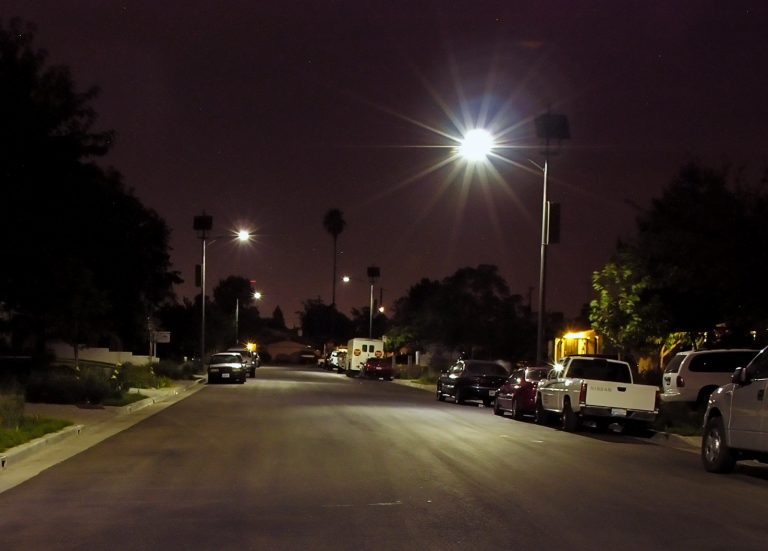Operating profiles. Array-to-load ratios. Depth of discharge. There’s a lot to consider when undertaking a large-scale lighting project and it’s easy to feel overwhelmed if you don’t “speak solar.”
We’re here to help. Whether you’re evaluating specs and components for a specific project or simply seeking to better understand the technology and benefits of off-grid solar lighting, we’ve got everything you need to know (and we’re keen to share!).
In this post—part two in a five-part series—we’re diving into solar panel sizing. We’ll cover the “golden rules” of proper solar sizing and share a simple calculation you can use to check that your prospective manufacturer has sized their array correctly.
Want to dig deeper? Our Ultimate Solar Lighting Guide gives a primer on how solar lighting works, why clients choose solar, and gets into the nitty-gritty of product specs.
When designing a solar lighting system, solar panels are carefully selected and sized to fit project requirements. The number of solar panels and the wattage of each panel are key to ensuring proper energy balance. An undersized solar array won’t generate enough power for the light fixture over the long term, causing the system to die prematurely. Likewise, an oversized solar array will generate more power than the system needs and will be unnecessarily expensive.
Golden rule #1 for sizing a solar light: The amount of energy collected by the solar array during the day (commonly referred to as “energy in”) should always exceed the amount of energy spent by the fixture at night (“energy out”).
This golden rule can be expressed as a ratio, which we refer to as the array-to-load ratio, or ALR. ALR is the ratio of the power collected by the solar panels (the array) to the power spent by the light fixture (the load). A proper ALR ensures a system’s battery can recover quickly during the day and still meet the required load output at night.
Tip: Look on your manufacturer’s spec sheet for the array-to-load ratio (ALR). A typical ALR is 1.2:1 or greater. Sometimes manufacturers remove the “:1” and just write it as “1.2.”
An ALR of 1.2 means the solar array generates 20% more power during the day than the light fixture uses at night.

Golden rule #2 for sizing a solar light: To ensure the system runs smoothly throughout the year, the amount of sun hours received on the area’s shortest day of the year (that’s December 21 in the Northern Hemisphere) should be the basis used to determine the size of the solar array.
Why? If a system is sized based on the average amount of sunlight received per day throughout the year, it should perform as expected during the spring and summer months. However, during the fall and winter, when there are fewer daylight hours than average, the solar array won’t be large enough to support the fixture load during the shorter days and longer nights.
At Sol, we always size our systems for the shortest day of the year. This ensures our solar lights generate enough power to run the light fixture every day of the year.
To ensure the prospective manufacturer has included the correct solar panel sizing (i.e., their ALR calculation meets your project needs), there is a simple calculation you can do. For this calculation, we’ll use an example project: a new collector road in Los Angeles, CA, that needs solar street lighting.
Let’s say your prospective manufacturer specifies a solar lighting system with a 40-watt light fixture running dusk-to-dawn. What is the energy load required for this system?
Because we should size the system to the shortest day of the year, we’ll use December 21 as the basis for our calculation. On December 21, Los Angeles has a 14-hour night, so the fixture will need to be on for 14 hours.
The load requirement for this system is approximately 560 watt-hours per night in the winter.
Next, we’ll multiply the manufacturer’s ALR (e.g., 1.2 or greater) by the load requirements. This will give us the amount of energy the solar panels need to generate during the day.
Divide this number by the solar insolation value for the project location. For Los Angeles, this is 4.2 sun hours per day based on the lowest monthly average (typically December). This will show us the solar panel wattage needed to meet our 672 watt-hours generated requirement.
At minimum, this lighting system will need a 160-watt solar panel. If the manufacturer has designed a system with a solar array of less than 160 watts, it will not be sustainable in the winter months.
To compensate for this power load imbalance (and save costs), the system may be designed to use unscheduled dimming to reduce the load and light levels in winter. While unscheduled dimming will prevent draining the battery too much and avoid premature battery failure, it also reduces the illumination of roadways and park trails during the months when there are more hours of activity in darkness.
If unscheduled dimming is a concern, make sure to ask the manufacturer if they use this method to preserve battery health so you know what will happen with your system in the winter.
Note: This equation does not include derating. Ask your manufacturer for more information.
If a manufacturer cannot size a system correctly or has a system with poor energy management, they may overcompensate by adding more or larger solar panels—and this is rarely a good thing. Why? Additional solar can:
To ensure your system uses correct solar panel sizing, you should always ask:
Finally, if you’re looking for a great simple tool to help you determine your sun hours, look no further.
Now that we know how to evaluate solar panel sizing, it’s time to learn how to assess system batteries. In part three of this series, we’ll review the types of batteries available and learn about depth of discharge. Stay tuned!
Articles in this series:
